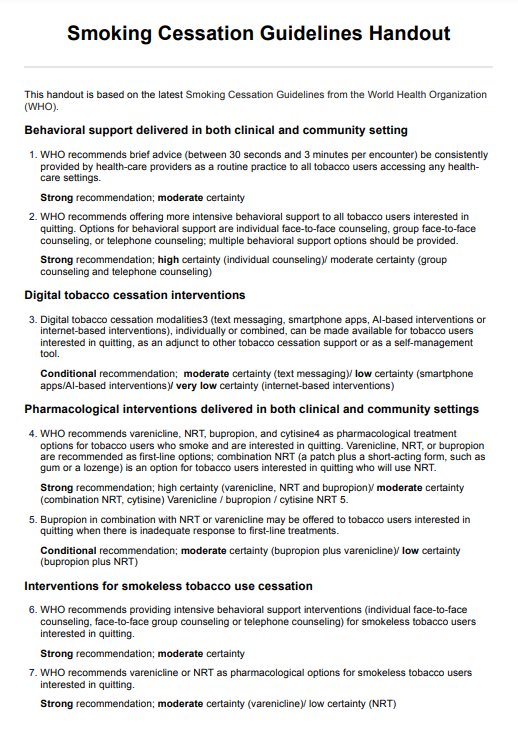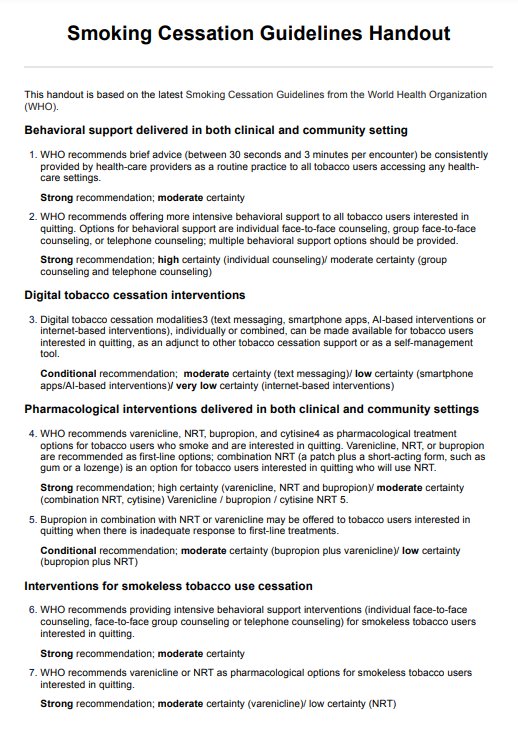Lyme Disease Treatment Guidelines Handout
Download Carepatron's free PDF handout and example of Lyme disease treatment guidelines to learn more about managing and treating this condition effectively.


What is Lyme disease?
Lyme disease, also called deer ticks, is a bacterial infection caused by Borrelia burgdorferi. People get Lyme disease through the bites of infected deer ticks. It's crucial to recognize and treat early Lyme disease promptly to prevent progression.
After an infected tick bite, early localized Lyme disease can develop, presenting with symptoms such as a distinctive bull's-eye rash, fever, chills, and fatigue. If left untreated, the bacteria can spread, leading to early disseminated Lyme disease, which might involve more severe tick bite symptoms such as multiple rashes, facial palsy, and joint pain. Chronic Lyme disease, a controversial and less understood condition, refers to persistent Lyme disease symptoms that some individuals experience even after treatment.
Diagnosing Lyme disease involves assessing Lyme disease symptoms and confirming them through laboratory tests. The primary treatment for Lyme disease typically involves oral medication, effective in early stages of the disease. However, if Lyme disease progresses to late Lyme disease, which can cause arthritis, neurological issues, and severe fatigue, more intensive treatments may be required. To prevent Lyme disease, it's essential to take precautions against tick bites, especially in areas known for high tick populations. Regular checks for ticks, using repellents, and wearing appropriate clothing can significantly reduce the risk.
Lyme Disease Treatment Guidelines Handout Template
Lyme Disease Treatment Guidelines Handout Example
Treatments for Lyme disease
The type of treatment for Lyme disease depends on the stage of the disease and the severity of the flu like symptoms. Here are the primary treatments for Lyme disease:
Oral antibiotics
For early-stage Lyme disease, antibiotics are the standard treatment. Common antibiotics such as doxycycline, amoxicillin, or cefuroxime axetil are prescribed for a course of 14 to 21 days, depending on the issues present. This treatment is effective in most Lyme disease patients, helping to eliminate the bacteria from the body and resolve symptoms like the characteristic Lyme disease rash.
For more specific information, check the guidelines on the template.
Intravenous antibiotics
In cases where Lyme disease has advanced or affected the nervous system, known as neurologic Lyme disease, intravenous (IV) antibiotics may be necessary. This treatment is typically administered for 14 to 28 days and targets bacteria that have spread to the brain and spinal cord. IV antibiotics are more intensive and are reserved for severe cases where oral antibiotics are insufficient.
Symptomatic treatments
Chronic Lyme disease, characterized by persistent symptoms despite antibiotic treatment, may require additional supportive therapies. Pain relievers, anti-inflammatory drugs, and medications to address specific symptoms, such as arthritis or neurologic issues, are commonly used.
Preventative measures
Preventing Lyme disease is an essential aspect of disease control. To avoid tick bites, individuals should take precautions such as using insect repellent, wearing protective clothing, and performing regular tick checks after spending time in wooded or grassy areas. Removing a deer tick promptly can reduce the risk of infection.
Ongoing research and developments
Research into Lyme disease continues to evolve, with new treatments and preventive measures being explored. Innovations in diagnostics and vaccines aim to reduce the incidence of Lyme disease and improve outcomes for those affected by tick bites.
How to use our treatment guidelines handout template?
Carepatron's treatment guidelines handout template is based on the 2020 guidelines jointly created by the Infectious Diseases Society of America, the American Academy of Neurology, and the American College of Rheumatology. Here's how the template can integrate into your assessment and treatment of a patient with Lyme disease symptoms.
Step 1: Download the template
(insert content here about accessing the template via the Carepatron app or via the button on this page)
Step 2: Assess the patient
Begin by assessing the patient’s symptoms and history. Determine if the patient has been bitten by deer ticks or has been in areas where infected ticks are prevalent. Look for early signs such as a Lyme disease rash, fever, and inflated lymph nodes.
Step 3: Confirm the diagnosis
Confirm early Lyme disease diagnosis by following guidelines. Order laboratory tests to detect the bacteria Borrelia burgdorferi, the causative agent of Lyme disease. Ensure to document all findings in the template for future reference.
Step 4: Plan and execute the treatment
Consult our guidelines to see the proper treatment strategy for your patient. For example, for high-risk Ixodes spp. bites in all age groups, the recommended chemoprophylaxis is a single oral dose of doxycycline within 72 hours of the tick's removal. The dose is 200 mg for adults and 4.4 mg per 1kg (up to a max of 200 mg) for children.
Ensure that you check other treatment strategies in the guidelines for other issues, such as what to do for patients with erythema migrans or Lyme-disease-related parenchymal involvement of the brain.
Benefits of using this handout
Using Carepatron's Lyme Disease Treatment Guidelines Handout offers several significant benefits to healthcare providers and their patients. Firstly, the handout provides a structured approach to managing Lyme disease, ensuring that healthcare provider follow standardized protocols based on current clinical practice guidelines. This consistency promotes efficiency and accuracy in diagnosis and treatment planning.
Secondly, the handout enhances patient education and engagement. It includes clear information about Lyme disease or deer tick symptoms, treatment options, and preventive measures against tick bites. This empowers patients to understand their condition better, adhere to prescribed treatments, and take proactive steps to prevent future infections.
Commonly asked questions
Yes, Lyme disease can typically be cured with prompt antibiotic treatment, especially in its early stages. However, some individuals may experience persistent symptoms despite treatment, which is known as chronic Lyme disease.
It's important to start treatment as early as possible after infection. Delayed treatment increases the risk of complications such as arthritis, neurological issues, and heart problems. However, treatment can still be effective even in later stages of the disease.
If Lyme disease is left untreated, it can lead to more severe symptoms affecting the joints, heart, and nervous system. Chronic Lyme disease, characterized by symptoms like fatigue, joint pain, and cognitive difficulties, may also develop in some individuals.







































































































